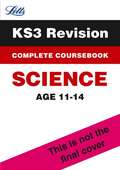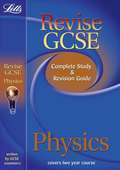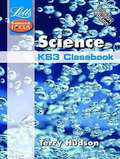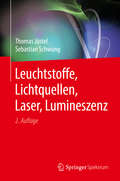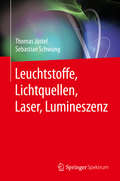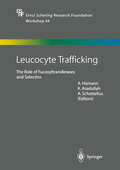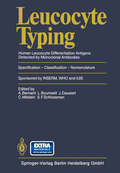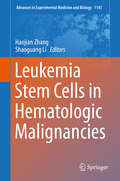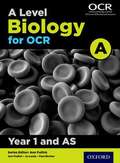- Table View
- List View
Letts KS3 Revision Success — KS3 SCIENCE COMPLETE COURSEBOOK (Letts Ks3 Revision Success Ser.)
by Letts Staff Letts Ks3 StaffThis unique and innovative coursebook provides complete coverage of the new programme of study for Key Stage 3 Science. It is specially designed to be used throughout the course to support all learning styles so that every student can achieve the best results. This innovative coursebook uses a blend of text, images and diagrams throughout to communicate all the essential information effectively for visual learners. Hands-on activities for every topic provide revision opportunities for Kinaesthetic learners. Free audio tracks talk auditory learners through all they key points. This three-pronged approach ensures all students learn what they need to by the end of KS3 and are well-prepared for their GCSE years.
Letts Revise GCSE - Physics: Complete Study and Revision Guide, Physics Study Guide (PDF)
by Carol TearThis ultimate study guide with in-depth GCSE course coverage is all you need for exam success. Revise GCSE Physics has everything you need to achieve the GCSE grade you want. It is written by GCSE examiners to boost learning and focus revision. Key facts highlight essential information Progress check questions test your learning Model GCSE answers show how examiners are looking for Exam questions provide crucial exam practice
Letts Science — KS3 SCIENCE FRAMEWORK EDITION CLASSBOOK (PDF)
by Terry HudsonThis new edition brings the Key Stage 3 Science Classbook fully into line with the requirements of the Framework for Teaching Science. The accessible and informative approach, along with the book's manageable format, make it a useful classroom resource.
Leuchtende Schichten im Faradayschen Dunkelraum der Glimmentladung in Brom-Argon-Gemischen (Forschungsberichte des Landes Nordrhein-Westfalen #1107)
by Paul ThomasLeuchtstoffe, Lichtquellen, Laser, Lumineszenz
by Thomas Jüstel Sebastian SchwungDas vorliegende Buch dient als Nachschlagewerk wichtiger Begriffe und Materialien, die im Bereich der Lumineszenz sowie der Lampen-, Laser-, Leuchtstoff- und Lichttechnik von Bedeutung sind. Es liefert somit Antworten und Daten zu Fragestellungen im Zusammenhang mit dem Fachgebiet der Photonik.
Leuchtstoffe, Lichtquellen, Laser, Lumineszenz
by Thomas Jüstel Sebastian SchwungDas vorliegende Buch dient als Nachschlagewerk wichtiger Begriffe und Materialien, die im Bereich der Lumineszenz sowie der Lampen-, Laser-, Leuchtstoff- und Lichttechnik von Bedeutung sind. Es liefert somit Antworten und Daten zu Fragestellungen im Zusammenhang mit dem Fachgebiet der Photonik.
Leucocyte Trafficking: The Role of Fucosyltransferases and Selectins (Ernst Schering Foundation Symposium Proceedings #44)
by ArndtSchottelius KhusruAsadullah AlfHamannAn essential component of inflammation is the migration of circulating leukocytes from blood into tissues. This process is characterized by a multistep paradigm of sequential cell adhesion and activation events that lead to the extravasation of specific leukocyte subsets to different tissues in health and disease. The first step of leukocyte extravasation, the rolling of leukocytes, is primarily mediated by the interactions of selectins and their ligands. It has recently become evident that fucosyltransferases are crucial for selectin ligand synthesis, inflammation, and skin homing. This book provides an in-depth overview of the mechanisms of leukocyte trafficking and of the molecular mechanisms of selectin/selectin ligand interactions and discusses options for pharmacological intervention to treat inflammatory diseases.
Leucocyte Typing: Human Leucocyte Differentiation Antigens Detected by Monoclonal Antibodies. Specification - Classification - Nomenclature / Typage leucocytaire Antigenes de differenciation leucocytaire humains reveles par lesanticorps monoclonaux: Rapports des etudes com
by Prof. Dr. Alain Bernard Dr Laurence Boumsell Prof. Dr. Jean Dausset Dr César Milstein Prof. Dr. Stuart F. SchlossmanLeucocytes: Methods and Protocols (Methods in Molecular Biology #844)
by Robert B. AshmanThe innate immune response is a crucial component of early resistance to infection, and it is now revealing increasing levels of complexity. The ability to modify the genome in vivo, has facilitated understanding of complex interactions between leucocytes and other components of the immune system, and phenotype-driven strategies using chemical mutagenesis have placed another powerful weapon in the armamentarium. In, Leucocytes: Methods and Protocols provides detailed protocols and practical advice on a variety of modern approaches to the study of leucocytes and their products. Written in the highly successful Methods in Molecular Biology™ series format, chapters include introductions to their respective topics, lists of the necessary materials and reagents, step-by-step, readily reproducible laboratory protocols, and key tips on troubleshooting and avoiding known pitfalls.Authoritative and practical, Leucocytes: Methods and Protocols seeks to aid scientists in further study into the immune system and leucocytes.
Leukemia Stem Cells: Methods and Protocols (Methods in Molecular Biology #2185)
by César Cobaleda Isidro Sánchez-GarcíaThe detailed volume aims to provide a comprehensive hands-on manual covering all the techniques involved in the cellular and molecular identification and characterization of both normal hematopoietic and leukemic stem cells, both from human patients and from mouse models of human leukemia. The book also covers the most frequently used experimental approaches for the generation of such stem cell-based models of human leukemia. Written for the highly successful Methods in Molecular Biology series, chapters include introductions to their respective topics, lists of the necessary materials and reagents, step-by-step, readily reproducible laboratory protocols, and tips on troubleshooting and avoiding known pitfalls. Authoritative and comprehensive, Leukemia Stem Cells: Methods and Protocols serves as an ideal guide for researchers, both expert and novice, seeking to further our knowledge of this vital avenue of cancer research.
Leukemia Stem Cells in Hematologic Malignancies (Advances in Experimental Medicine and Biology #1143)
by Haojian Zhang Shaoguang LiThis book introduces readers to the biology of leukemia stem cells (LSCs) and emphasizes the necessity and importance of targeting LSCs in the treatment of hematopoietic malignancies. It addresses the role of leukemia stem cells in different leukemia diseases and molecular signatures, as well as the metabolic and epigenetic regulation of leukemia stem cell function. With regard to solid tumors, a significant number of blood cancers are believed to be derived from leukemia stem cells (LSCs), which are responsible for disease progression, relapse and drug resistance. Consequently, new therapeutic strategies need to be developed by focusing on the complete eradication of LSCs. Given its scope, the book offers a valuable asset for graduate students and scientists in the fields of cell biology and cancer research etc.
Leukocyte Adhesion Molecules: Proceedings of the First International Conference on: "Structure, Function and Regulation of Molecules Involved in Leukocyte Adhesion", Held in Titisee, West Germany, September 28 - October 2, 1988
by Timothy A. Springer Donald C. Anderson Alan S. Rosenthal Robert RothleinLeukocyte adhesion molecules promise to be highly effective as antigens in the antibody-directed leucocyte elimination treatment prior to grafting or in cases of acute and chronic inflammatory disease. This comprehensive review of contemporary research provides thorough discussions of the structure of these molecules, their in vitro function, and the role that they play in vivo as evidenced by results shown in inflammatory models where antibodies against these molecules are given to inhibit their function. The blend of basic science and clinical applications provides clear evidence of the biological relevance of cell-cell interactions and the many potential clinical dividends afforded by understanding the molecular basis of cell adhesion.
Leukocyte Integrins in the Immune System and Malignant Disease (Current Topics in Microbiology and Immunology #231)
by Bernhard Holzmann Hermann WagnerMost lymphocytes recirculate throughout the body, migrating from blood through organized lymphoid tissues such as lymph nodes (LN) and Peyer's patches (PP), then to lymph and back to blood (GOWANS and KNIGHT 1964). Smaller numbers of lymphocytes migrate from blood to extranodal tissues such as pancreas and then through lymphatic vessels to LN (MACKAY et al. 1990). An important feature of this migration is the ability of lymphocytes to recognize and adhere to the surface of blood vessel endothelial cells before migrating through the vessel wall into surrounding tissue (CARLOS and HARLAN 1994; IMHOF and DUNON 1995; BUTCHER and PICKER 1996). Adhesion interactions of vascular endothelium with lymphocytes under flow or shear consist of at least four steps: (I) an initial transient sticking or rolling; (2) if the lymphocytes encounter appropriate activating or chemotactic factors in the local environment, rolling may be followed by a lymphocyte activation step that then leads to; (3) strong adhesion or sticking that may be followed by; (4) lym phocyte diapedesis into tissue (BUTCHER 1991; SHIMUZU et al. 1992; SPRINGER 1994; BARGATZE et al. 1995). Specific lymphocyte and endothelial adhesion molecules (AM) are involved in each step of this "adhesion cascade" (reviewed in CARLOS and HARLAN 1994; IMHOF and DUNON 1995; BUTCHER and PICKER 1996). This allows lymphocyte migration to be controlled at several different steps, leading to a combinatorial increase in specificity and sensitivity.
Leukocyte Recruitment, Endothelial Cell Adhesion Molecules, and Transcriptional Control: Insights for Drug Discovery
by Tucker CollinsThe localized attachment of circulating leukocytes to endothelium has been recognized as the cellular hallmark of the inflammatory response. This adhesive interaction, a necessary antecedent to the emigration of leukocytes from the blood into the tissues, is mediated by vascular adhesion molecules. Leukocyte Recruitment, Endothelial Cell Adhesion Molecules and Transcriptional Control: Insights for Drug Discovery outlines some of the cellular and molecular mechanisms of inflammation with contributions from top researchers. This volume provides an overview of three of these endothelial adhesion molecules, as examples of key mediators of leukocyte recruitment. It reviews the structure and regulation of these cell surface proteins and focus on the rapidly expanding field of transcriptional regulation of these inducible proteins, and closes with a discussion of drug discovery possibilities that target the regulation of leukocyte recruitment. This book will be of interest for any researchers, in academia or industry, looking for an overview of leukocyte recruitment or novel approaches to drug discovery.
Leukocyte Typing II: Volume 2 Human B Lymphocytes
by Ellis L. Reinherz Barton F. Haynes Lee M. Nadler Irwin D. BernsteinLeukocyte Typing II: Volume 3 Human Myeloid and Hematopoietic Cells
by Ellis L. Reinherz Barton F. Haynes Lee M. Nadler Irwin D. BernsteinLeukocyte Typing II: Volume 1 Human T Lymphocytes
by Ellis L. Reinherz Barton F. Haynes Lee M. Nadler Irwin D. BernsteinLeukosen · Leukoblastome Mycosis Fungoides Lymphogranulomatose (Handbuch der Haut- und Geschlechtskrankheiten #A / 8 / 1)
by L. Arƶt H. Fuhs K. Herxheimer H. Martin S. SchoenhofDieser Buchtitel ist Teil des Digitalisierungsprojekts Springer Book Archives mit Publikationen, die seit den Anfängen des Verlags von 1842 erschienen sind. Der Verlag stellt mit diesem Archiv Quellen für die historische wie auch die disziplingeschichtliche Forschung zur Verfügung, die jeweils im historischen Kontext betrachtet werden müssen. Dieser Titel erschien in der Zeit vor 1945 und wird daher in seiner zeittypischen politisch-ideologischen Ausrichtung vom Verlag nicht beworben.
Leung's Encyclopedia of Common Natural Ingredients: Used in Food, Drugs and Cosmetics
by Ikhlas A. Khan Ehab A. AbourashedThe third edition of the unparalleled reference on natural ingredients and their commercial use This new Third Edition of Leung's Encyclopedia of Common Natural Ingredients: Used in Food, Drugs, and Cosmetics arrives in the wake of the huge wave of interest in dietary supplements and herbal medicine resulting from both trends in health and the Dietary Supplement and Health Education Act of 1994 (DSHEA). This fully updated and revised text includes the most recent research findings on a wide variety of ingredients, giving readers a single source for understanding and working with natural ingredients. The Encyclopedia continues the successful format for entries listed in earlier editions (consisting of source, description, chemical composition, pharmacology, uses, commercial preparations, regulatory status, and references). The text also features an easily accessible alphabetical presentation of the entries according to common names, with the index cross-referencing entries according to scientific names. This Third Edition also features: More than 50 percent more information than the Second Edition, reflecting the greatly increased research activity in recent years A new section on traditional Indian medicine, with information on nine commonly used herbs More than 6,500 references Two new appendices explaining and illustrating the botanical terminology frequently encountered in the text A revised and expanded index Leung's Encyclopedia of Common Natural Ingredients: Used in Food, Drugs, and Cosmetics, Third Edition will continue to provide a comprehensive compilation of the existing literature and prominent findings on natural ingredients to readers with an interest in medicine, nutrition, and cosmetics.
Leung's Encyclopedia of Common Natural Ingredients: Used in Food, Drugs and Cosmetics
by Ikhlas A. Khan Ehab A. AbourashedThe third edition of the unparalleled reference on natural ingredients and their commercial use This new Third Edition of Leung's Encyclopedia of Common Natural Ingredients: Used in Food, Drugs, and Cosmetics arrives in the wake of the huge wave of interest in dietary supplements and herbal medicine resulting from both trends in health and the Dietary Supplement and Health Education Act of 1994 (DSHEA). This fully updated and revised text includes the most recent research findings on a wide variety of ingredients, giving readers a single source for understanding and working with natural ingredients. The Encyclopedia continues the successful format for entries listed in earlier editions (consisting of source, description, chemical composition, pharmacology, uses, commercial preparations, regulatory status, and references). The text also features an easily accessible alphabetical presentation of the entries according to common names, with the index cross-referencing entries according to scientific names. This Third Edition also features: More than 50 percent more information than the Second Edition, reflecting the greatly increased research activity in recent years A new section on traditional Indian medicine, with information on nine commonly used herbs More than 6,500 references Two new appendices explaining and illustrating the botanical terminology frequently encountered in the text A revised and expanded index Leung's Encyclopedia of Common Natural Ingredients: Used in Food, Drugs, and Cosmetics, Third Edition will continue to provide a comprehensive compilation of the existing literature and prominent findings on natural ingredients to readers with an interest in medicine, nutrition, and cosmetics.
A Level Advancing Physics For OCR Year 2 Student Book (PDF)
by Lawrence Herklots John MillerNew and updated resources tailored to the 2015 Advancing Physics specification in partnership with OCR. With new accessible format and features throughout, this Student Book retains the ethos of Advancing Physics while providing full support for the new linear qualification.
A Level Biology For OCR: Year 1 and AS (PDF)
by Ann Fullick Paul Bircher Jo LockeWritten by curriculum and specification experts, this student book supports and extends students through the new course whilst delivering the breadth, depth, and skills needed to succeed in the new AS and beyond.
A Level Biology for OCR A
by Ann Fullick Jo Locke Paul BircherWritten by curriculum and specification experts, this Student Book supports and extends students through the new linear course while delivering the breadth, depth, and skills needed to succeed in the new A Levels and beyond. It develops real subject knowledge as well as essential exam skills.
A Level Biology for OCR A: Year 1 and AS
by Jo Locke Paul BircherWritten by curriculum and specification experts, this Student Book supports and extends students through their course while delivering the breadth, depth, and skills needed to succeed at A Level and beyond. It develops true subject knowledge while also developing essential exam skills.
A Level Biology for OCR Year 2 Student Book (PDF)
by Ann Fullick Jo Locke Paul BircherWritten by curriculum and specification experts, this Student Book supports and extends students through the new linear course while delivering the breadth, depth, and skills needed to succeed in the new A Levels and beyond. It develops real subject knowledge as well as essential exam skills.
